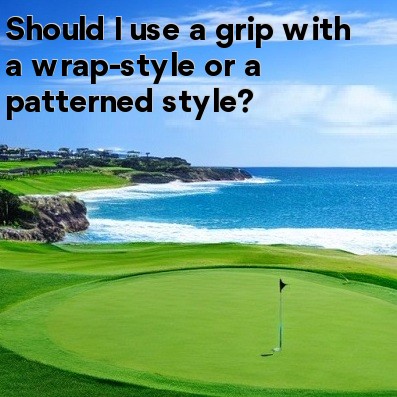
Should I use a grip with a wrap-style or a patterned style?
When it comes to the game of golf, one of the most crucial aspects of your swing is the grip. How you hold the club can significantly impact your shot quality and accuracy. But with so many grip options available, it can be challenging to determine which style is right for you.
Two common grip styles that you'll often come across are the wrap-style grip and the patterned style grip. Let's take a closer look at each and see which one might be more suitable for your game:
- Wrap-Style Grip:
The wrap-style grip, also known as the overlapping grip, is one of the most popular grip choices among professional golfers. With this grip, you place your pinky finger of your trailing hand (right hand for right-handed golfers) over the gap between your lead hand's index and middle finger.
Using a wrap-style grip offers several advantages. Firstly, it promotes better control over the club during the swing, allowing for a more consistent release at impact. This grip can also help mitigate the potential for a slice, common among many amateur golfers. Additionally, the wrap-style grip provides a comfortable and secure feel, increasing confidence throughout your swing.
On the flip side, some golfers find the wrap-style grip less natural and more challenging to learn initially. It may take some time to build up the necessary muscle memory and proficiency with this grip style.
- Patterned Style Grip:
The patterned style grip, also known as the ten-finger grip or baseball grip, involves placing all ten fingers on the club. This grip style is commonly used by beginners, children, or individuals with weaker hands.
The patterned style grip offers increased strength and stability during the swing. By having all ten fingers in contact with the club, it enables a tighter grip, potentially generating more power and distance. Moreover, this grip can help reduce the likelihood of hooks or slices, making it suitable for golfers struggling with those shot tendencies.
However, despite its advantages, there are some downsides to the patterned style grip. The lack of finger overlap may limit wrist mobility during the swing, potentially resulting in less control and consistency. Additionally, this grip style may feel less natural for experienced golfers who have been using the wrap-style grip for an extended period.
Ultimately, the choice between a wrap-style grip and a patterned style grip depends on your personal preference, physical abilities, and level of expertise. Both grip styles have their own set of pros and cons, so it may be worthwhile to experiment and determine which grip feels most comfortable and effective for your game.
It's also worth noting that professional golf instructors can provide valuable insight and guidance on grip selection. They can assess your swing mechanics and recommend the grip style that best suits your needs and goals.
In conclusion, the wrap-style grip and patterned style grip are two popular options in golf. Consider their advantages and disadvantages, evaluate your own abilities, and seek professional advice if needed, before making a decision. Ultimately, the grip that allows you to have better control, consistency, and confidence in your swing is the one that will benefit you the most in your game.





